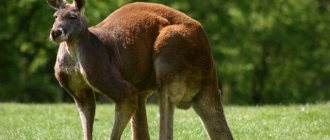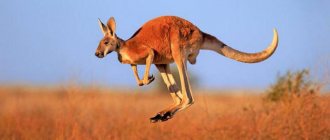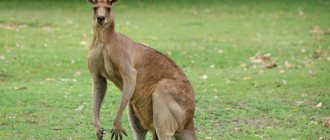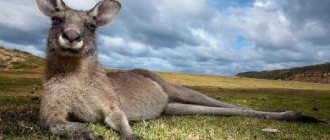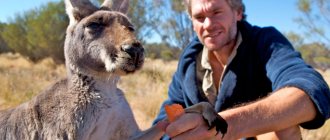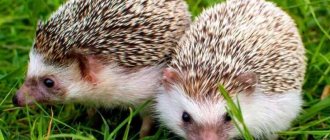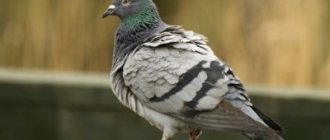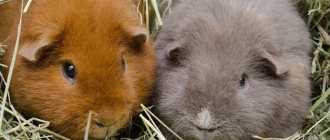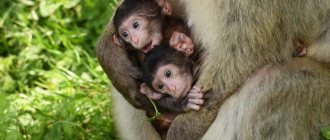How diverse the world is, how many amazing plants and animals live on our planet! And the kangaroo can safely be considered such a bright representative of nature, another of its miracles. Surely everyone knows in which country the kangaroo lives. Of course, in Australia. But many may have a question about where kangaroos live, besides Australia. They also live in New Zealand, New Guinea, the Bismarck Archipelago and Tasmania. In total there are more than fifty species of these animals. They all vary in size and weight. There are giant kangaroos: red and gray, there are kangaroo rats, wallabies - medium-sized individuals, and others.
Kangaroo: description of the animal
This animal is a marsupial. The growth of gigantic kangaroos is quite impressive. Males grow from one hundred to one hundred and seventy centimeters in height, and weigh from twenty to forty kilograms. Females are slightly smaller, their height is from seventy-five centimeters to one meter, their weight is from eighteen to twenty-two kilograms. The coat color ranges from light gray to reddish red. All kangaroos have a bare black nose and long ears. Thanks to such ears, the animal can pick up even the faintest sounds, which allows it to hear the approach of an enemy in time.
Kangaroos have very long hind legs and a tail, thanks to which the animal maintains balance while moving. And they move exclusively by jumping. Thanks to its powerful hind legs, the animal reaches speeds of up to 60 km/h when running, and up to 90 km/h when running away from a predator. But at this speed the animal can only run for a short time. Its front legs are short, with very long claws, with which they defend themselves from predators and dig holes in search of water. And thanks to their claws, males sort things out with each other.
The question arises: how long do kangaroos live? And they live for about eighteen years. They reach sexual maturity at about two years of age. Animals can mate throughout the year. The female's pregnancy lasts thirty-two days. A baby kangaroo is called a joey. He is born blind and without fur, and also absolutely tiny - two and a half centimeters. Immediately after birth, the cub crawls to its mother's pouch, where it remains for up to six months. Having reached the age of six months, the baby begins to take his first steps, but still returns to the pouch. There he lives for up to nine months. It should be noted that only females have a pouch. It has four nipples. The female simultaneously produces several types of milk for different ages of her cub. The fact is that she, having still a very small cub, may be pregnant. And the bag can contain several cubs of different ages at once. The female kangaroo can regulate the size of her bag - making it larger or smaller. Joey is growing and therefore needs more space, but when the mother moves, the walls of the pouch are compressed so that the baby does not jump out.
Nutritional Features
Kangaroos are the only large land animals that use jumping as a means of transportation. The flight speed for the largest species is about 20-25 kilometers per hour, but can reach 70 km/h over short distances.
During the jump, the powerful calf muscles lift the body off the ground, while the smaller plantaris muscle, which attaches to the big fourth toe, is used to push off. Seventy percent of potential energy is stored in elastic tendons. At slow speeds, pentapedal locomotion is used, using the tail while propelling the hind legs forward.
Kangaroos are skilled swimmers ; they often flee to bodies of water if they are threatened by a predator. When chasing, they can use their front paws to hold an enemy underwater to drown them. Kangaroos have single-chamber stomachs, quite different from cattle and sheep. They sometimes regurgitate vegetation they have eaten, chew it like cud, and then swallow it again for final digestion. However, this does not happen very often.
Different species feed differently, although they are all herbivores. The eastern gray feeds only on pasture, while some other species such as the red include a significant amount of shrubs in their diet.
Due to their herding habits, kangaroos have developed specialized teeth that are rare among mammals. Its incisors are capable of cutting grass, which is then crushed by its molars. Because the two sides of the lower jaw are not connected together, the incisors on the lower jaw are further apart, resulting in a wider bite.
Animal lifestyle. Where do kangaroos live in Australia?
Animals live in rocky areas of the continent. There they feel more secure. Kangaroos are social animals. The family consists of a male and several females. When the cub reaches sexual maturity, he leaves the family and creates his own. These animals feed exclusively on plant foods. During drought, they can independently obtain water by digging deep (up to one meter deep) holes. They can also get the water they need from food. Animals are nocturnal. It is at dusk that they go out to pastures to eat lush grass, and during the day they rest in the shade of trees, hiding from the scorching sun. If any animal hears the approach of an enemy, it immediately begins to loudly knock with its hind legs, warning its relatives of the danger. From time immemorial, on the continent where kangaroos live, there were no predators, and the animals felt absolutely safe.
But with the arrival of Europeans on the island, a threat loomed over the kangaroos. Some of the imported dogs went wild - they began to be called dingo dogs. And now it is they who have become the main enemies of the kangaroo. When attacked by a predator, the animal tries to lure it into the water and drown it. If there is no body of water nearby, then the kangaroo runs to the nearest tree, rests its back against it and delivers a crushing blow with its hind legs. And the paws are really strong. A kangaroo can easily jump over a three-meter fence. Where the kangaroo lives, there are no other large predators. But animals may be subject to another misfortune. Very dangerous for kangaroos are midges, which clog the eyes, causing severe inflammation. The animal may go blind!
Kangaroos trust people and are practically not afraid of them. Very often these animals can be found in the park or forest. If you go to where kangaroos live and you are lucky enough to meet them, then there is a high probability that the animal will even allow itself to be photographed.
Offspring and lifestyle
These animals are active at night. At dusk, they go out into clearings and pastures to begin their main meal. During the day, red-haired inhabitants of forest-steppes and plains hide in holes or in the dense shade of trees.
The main enemies of kangaroos in Australia are dingoes. Dogs often raid pastures where kangaroos feed. In order to avoid an attack, some individuals warn their fellows about the danger by stamping their feet, snorting and even grunting. Kangaroos can also make hissing sounds.
Kangaroos raise their young in a pack, where one male protects several females. Kangaroos give birth to one baby at a time. In good habitat, a flock of animals can consist of one hundred individuals.
Leaves of trees and shrubs, grass, shoots and bark are the kangaroo's favorite food. Small individuals feed on mother's milk for a long period.
The first birth of a female of this species occurs at two years. Kangaroos live up to 10-19 years. Although there are individuals that can live up to 30 years.
A tiny baby kangaroo spends 11 months in a pouch. The female animal is capable of delaying the birth of the next baby if the previous one is not yet ready to leave the pouch on her stomach.
History of the name of the animal
The animal received such an eccentric name - “kangaroo” - thanks to the discoverers of a continent unknown at that time. When the Europeans saw these amazing animals, they asked the aborigines: “Who is this?” To which the locals responded, “Ken Gu Ru,” which translates to “we don’t understand.” The sailors thought that this was the name of the animal. That’s how the name “kangaroo” stuck to him.
Wild mongooses near the Caribbean Sea
The name "wild Caribbean mongoose" sounds a little scary, but it is actually a small creature. The mongoose is a small carnivorous animal that appears in Rudyard Kipling's Rikki-Tikki-Tavi.
"Mongoose" is the common name for thirty different species in the family Herpestidae. These animals are serious little hunters found naturally in Eurasia and Africa. They are hardy creatures that are very good at protecting themselves from predators.
“Fisherman’s” sandals and 4 more pairs of shoes without heels, in which your feet will not get tired
Discreet but tasteful: several pearl manicure ideas for spring
“Don’t divide yourself into parts”: Tina Kandelaki on how to find your man
In the mid-1800s, colonizers began introducing mongooses to many Caribbean islands in an attempt to control rat populations on their sugarcane plantations. This seemed to work, but unfortunately the mongooses began preying on the eggs of birds and sea turtles and are now considered more of an environmental problem than a solution.
Wallaby
Wallabies are marsupials belonging to the Kangaroo family. It is an exact copy of a gigantic kangaroo, only in a smaller form. These animals reach seventy centimeters in height and weigh up to twenty kilograms. There are up to fifteen species of this animal, some are on the verge of extinction, such as the striped wallaby. Almost nothing remains of the once abundant species. They are found only on two islands located off the west coast of Australia. There are mountain wallabies, and there are swamp wallabies. They do not differ in appearance and habits - only in their habitat.
Interaction with people
The kangaroo has always been a very important animal to the Aboriginal people of Australia because of its meat, skin, bones and sinew. Skins were also sometimes used. There are reports that some tribes used stuffed animals as a ball for the traditional game of marngruk.
Unlike many small macropods, kangaroos have thrived since European settlement. Colonists cleared forests to create extensive pastures for sheep and cattle, added water reserves in dry areas, and significantly reduced the number of dingoes.
Kangaroos under normal conditions do not pose a threat to people . There are very few records of unprovoked attacks, yet several such unprovoked attacks in 2004 raised fears of rabies affecting marsupials.
The only reliably documented case of human death occurred in New South Wales in 1936. A hunter was killed while trying to save his two dogs from an animal. Other suspected causes of erratic and dangerous behavior include extreme thirst and hunger.
Historically, kangaroos were a source of food for Indigenous Australians. Their meat has a high concentration of conjugated linoleic acid compared to other foods and is a rich source of vitamins and minerals. Most meat now comes from wild animals, as a by-product of population control programs.
Kangaroo rat
The second name of the animal is musk kangaroo. This animal is small in size. Its body reaches a length of forty centimeters, a third is the tail. It is covered with dark thick fur, on which red specks can be seen. The fur on the hind legs is dark brown, but the feet are completely bare. In appearance, the animals are very similar to ordinary kangaroos. The animals live in hard-to-reach thickets along river banks. These animals lead a diurnal lifestyle, lazily digging through plant waste in search of insects, earthworms and plant tubers. They also eat grass, tree bark and palm tree fruits. Females carry their young in a pouch.
Enemies
In nature, kangaroos' enemies include dingoes, foxes, birds of prey and snakes. Fires are often the cause of animal death.
The active settlement of the continent and the development of numerous pastures and watering holes for sheep had a positive effect on the kangaroo population: by the end of the 19th century, their numbers increased noticeably. The breeding animals, in search of food, began to raid pastures, devastating them. In order to protect the land, local farmers shoot kangaroos, killing up to 3,000 individuals annually. Marsupial meat is valued for its taste and low calorie content, so they often become victims of poachers.
Brush-tailed kangaroo
This marsupial is the size of a rabbit. Its fur is quite long, the upper part is dark in color with black speckles, and the fur on its belly is off-white. This species of kangaroo gets its name from the ridge of shaggy black hair on part of its tail. Its body length is sixty-seven centimeters, of which thirty-one is the tail. The animal digs holes in the ground, which it lines with grass and branches, creating a kind of nest. The brush-tailed kangaroo chooses a place for its bed in dense thickets of grass, so it is very difficult to see it in the wild. During the day, animals lie in their nests and come out to feed at night. The animals feed on grass and plant roots, which they very deftly dig out of the ground.
Australia, the country where kangaroos live, is an amazing place. And if you have the opportunity to visit this wonderful continent, go. At least to see the wonderful kangaroos with your own eyes.
Lifestyle
Some of the largest species of these animals form groups of 50 or more individuals, and they can repeatedly leave the group and rejoin it. Males move from one group to another more often than females; They also use large areas of habitat.
Large social species live in open areas. They used to be attacked by land and air predators such as dingoes, wedge-tailed eagle and marsupial wolf (which is now extinct). Living in a group gives marsupials undeniable advantages. For example, dingoes are unlikely to approach a large herd, and kangaroos may spend more time feeding. The size of groups depends on population density, habitat type and other factors.
However, most small species are solitary animals. Only occasionally can you meet 2-3 individuals in one company.
As a rule, kangaroos do not have homes, with the exception of musk kangaroo rats. Some species, such as brushtails, make shelters in burrows that they dig themselves. Rock kangaroos take refuge during the day in crevices or piles of stones, forming colonies.
Kangaroos are usually most active during twilight and night hours. During the day, in the heat, they prefer to rest somewhere in a shady place.
Diet
The basis of the kangaroo's diet is plant food, including grass, leaves, fruits, seeds, bulbs, mushrooms and rhizomes. Some small species, particularly potoroos, often supplement their plant diet with invertebrates and beetle larvae.
Short-faced kangaroos prefer underground parts of plants - roots, rhizomes, tubers and bulbs. This is one of the species that eats mushrooms and spreads spores.
Small wallabies feed mainly on grass.
In wooded habitats, the kangaroo's diet includes more fruit. In general, many types of plants are eaten: marsupials eat various parts of them depending on the season.
Wallaroos, red and gray kangaroos prefer the leaves of herbaceous plants, also not missing the seeds of cereals and other monocots. Interestingly, large species can feed only on grass.
